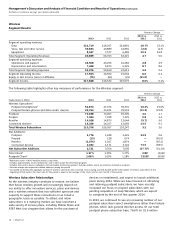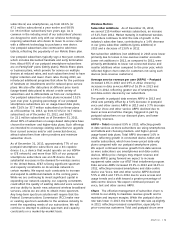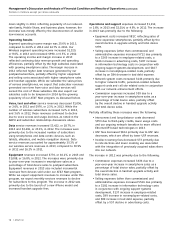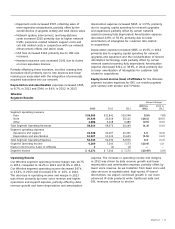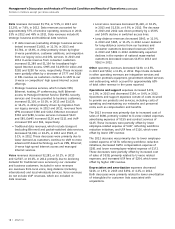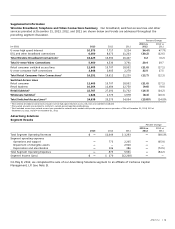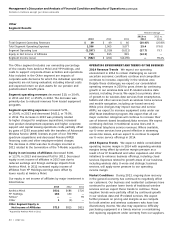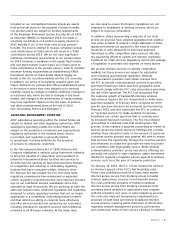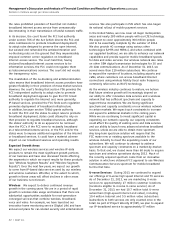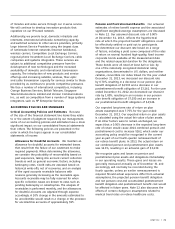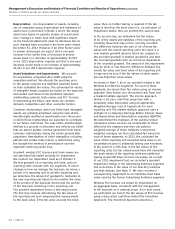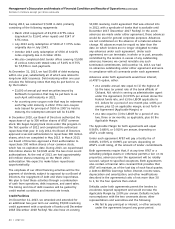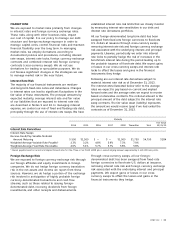AT&T Wireless 2013 Annual Report Download - page 26
Download and view the complete annual report
Please find page 26 of the 2013 AT&T Wireless annual report below. You can navigate through the pages in the report by either clicking on the pages listed below, or by using the keyword search tool below to find specific information within the annual report.
Management’s Discussion and Analysis of Financial Condition and Results of Operations (continued)
Dollars in millions except per share amounts
24 | AT&T Inc.
Wireline
Our wireline subsidiaries will face continued competitive
pressure in 2014 from multiple providers, including wireless,
cable and other VoIP providers, interexchange carriers and
resellers. In addition, economic pressures are leading
customers to terminate their traditional local wireline
service and use competitive wireless and Internet-based
services, intensifying a pre-existing trend toward wireless
and Internet use. In most markets, we compete, often on
pricing of bundled services, with large cable companies,
such as Comcast Corporation, Cox Communications Inc.
and Time Warner Cable Inc., for local, high-speed Internet,
video and voice services customers and other smaller
telecommunications companies for both long-distance
and local services customers.
Our wireline subsidiaries generally remain subject to
regulation for wholesale services by state regulatory
commissions for intrastate services and by the FCC for
interstate services. Under the Telecom Act, companies
seeking to interconnect to our wireline subsidiaries’
networks and exchange local calls enter into
interconnection agreements with us. Any unresolved
issues in negotiating those agreements are subject to
arbitration before the appropriate state commission.
These agreements (whether fully agreed-upon or
arbitrated) are then subject to review and approval
by the appropriate state commission.
Our wireline subsidiaries operate under state-specific
forms of regulation for retail services that were either
legislatively enacted or authorized by the appropriate
state regulatory commission. Most states deregulate the
competitive services; impose price caps for some services
where the prices for these services are not tied to the
cost of providing the services or to rate-of-return
requirements; or adopt a regulatory framework that
incorporates deregulation and price caps. Some states
may impose minimum customer service standards with
required payments if we fail to meet the standards.
We continue to lose access lines due to competitors
(e.g., wireless, cable and VoIP providers) who can provide
comparable services at lower prices because they are
not subject to traditional telephone industry regulation
(or the extent of regulation is in dispute), utilize different
technologies, or promote a different business model
(such as advertising based) and consequently have lower
cost structures. In response to these competitive pressures,
for several years we have utilized a bundling strategy
that rewards customers who consolidate their services
(e.g., long-distance telephone, high-speed Internet, wireless
and video) with us. We continue to focus on bundling
wireline and wireless services, including combined packages
their authority to do so appears to be narrower than
the FCC’s. If the FCC were to reclassify broadband as a
telecommunications service, or the FCC and/or the states
were to impose additional regulation of the Internet or
broadband services, it could have a material adverse
impact on our broadband services and operating results.
COMPETITION
Competition continues to increase for telecommunications
and information services. Technological advances have
expanded the types and uses of services and products
available. In addition, lack of or a reduced level of
regulation of comparable alternatives (e.g., cable, wireless
and VoIP providers) has lowered costs for these alternative
communications service providers. As a result, we face
heightened competition as well as some new opportunities
in significant portions of our business.
Wireless
We face substantial and increasing competition in all
aspects of our wireless business. Under current FCC rules,
multiple licensees, including six or more PCS licensees,
two cellular licensees and one or more enhanced
specialized mobile radio licensee may operate in each
of our service areas, which results in the potential presence
of multiple competitors. Our competitors include brands
such as Verizon Wireless, Sprint, T-Mobile, Metro PCS and
Cricket Wireless, a larger number of regional providers of
cellular, PCS and other wireless communications services
and resellers of those services (see Note 5 for a discussion
of our pending acquisition of Leap). In addition, we face
competition from providers who offer voice, text messaging
and other services as applications on data networks.
More than 97 percent of the U.S. population lives in areas
with at least three mobile telephone operators, and
90 percent of the population lives in areas with at least
five competing carriers. We may experience significant
competition from companies that provide similar services
using other communications technologies and services.
While some of these technologies and services are now
operational, others are being developed or may be
developed. We compete for customers based principally
on service/device offerings, price, call quality, coverage
area and customer service.
The FCC may develop rules to auction or otherwise make
available additional spectrum to the wireless industry.
The FCC has indicated it plans to conduct an auction in
2014 under which up to 120 MHz of UHF TV spectrum could
be reallocated for mobile wireless use. In addition, the FCC
is required by law to auction up to 65 MHz of additional
wireless spectrum in 2015. The FCC has yet to develop the
rules under which this spectrum might be available.


